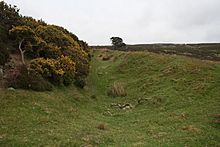|
|
|
|
Ringses Camp, Beanley MoorHillfort
|
||||||||||||||||||||||||
|
|
|
Images (click to view fullsize) |
|
Photographs:














 Artistic / Interpretive:
Artistic / Interpretive:

|
Fieldnotes |
|
|
What a weird site. I first saw this set of earthworks (I'm not happy calling it a 'fort', 'camp' is also a bit iffy tbh...) almost 30 years ago, but then just in the distance as I was wandering about exploring the area around a small festival at one of the farms at the edge of the moor. Since then I've looked at it in the distance a few times, and on aerial shots, it's quite easily visible, and merits some seriously confident dashes on the OS map, so I knew the ramparts were fairly high. But actually having a walk about in there for the first time, I was surprised by how small it is in footprint. There's barely enough room for a house, though apparently there was one during a Romano-British re-occupation period of use. I couldn't quite shake the feeling that it might have also been re-used more recently, mebbe during the border reiver years. So the overall effect is quite impressive. Because the ramparts are 4m high in places, so it's got an almost claustrophobic feel to it. Oddly small 'fort'. Lotsa Bronze age stuff nearby. Access isn't too tricky if you go when the bracken is low. Bloody annoying round this neck of the woods if it's high. Go have a look if you're in the area. |
 Posted by Hob
Posted by Hob19th June 2017ce |
|
I'm sure Iron Age hillforts have their interest and like many in Northumberland the location is often stunning, as it was here. The many-walled fort was probably built more for show than for defense and may have been visible from some distance. Similar to the Doddington Ringses, there is also traces here of man's earlier use of the landscape by the finding of rock-art. Two panels were found in the region of the fort in the 1860s and moved to Alnwick Castle Museum. They are illustrated by Stan Beckensall (2001 p166) who also shows the earlier drawings of Collingwood Bruce. Apart from a rock slab given in the Beckensall archive as Beanley Moor 1, most of the carved rock now present in the landscape appear to be of the unimpressive cup-marked variety. They are certainly quite challenging to find, and even harder to interpret! I'm certain there are more out there but there are alot of rocks to examine and in this game the light is not always perfect. |
Posted by rockandy 30th January 2005ce Edited 30th January 2005ce |
Links |
|
Internet ArchiveNotes Archaeological, Geological, etc. on Beanley Moor and the vicinity of Kemmer Lough. From the MSS of George Tate. In the History of the Berwickshire Naturalists Club, volume 23, 1890. He mentions the carved stones, and also the 'detached blocks of stones which are usually covered over with lichens, and hoary with age, are here called "Grey Mares".' |
 Posted by Rhiannon
Posted by Rhiannon15th June 2017ce |

